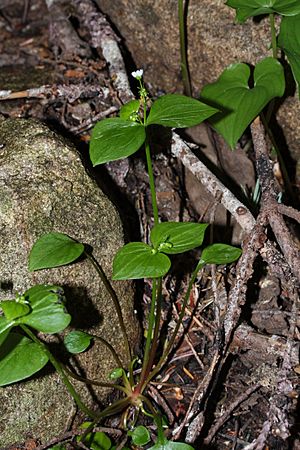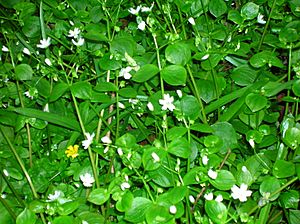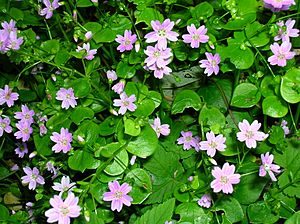Claytonia sibirica facts for kids
Quick facts for kids Claytonia sibirica |
|
|---|---|
 |
|
| Scientific classification | |
| Genus: |
Claytonia
|
| Species: |
sibirica
|
Claytonia sibirica, also known as the pink purslane, candy flower, or Siberian spring beauty, is a pretty flowering plant. It belongs to the Montiaceae family. This plant naturally grows in places like the Commander Islands in Siberia and along the west coast of North America. You can find it from the Aleutian Islands and coastal Alaska all the way down to the Santa Cruz Mountains in California. It also grows in some inland areas like northern Idaho. This plant was brought to the United Kingdom many years ago and is now very common there.
Contents
Where Does it Grow and What Does it Look Like?
This plant loves to grow in damp, wooded areas. It can live for many years (a perennial), two years (a biennial), or just one year (an annual). Its flowers have both male and female parts. They usually bloom from February to August, but some can keep flowering into the autumn.
The plant has many fleshy stems that grow in a circular shape, like a rosette. Its leaves can be long and narrow, spear-shaped, or triangular. The flowers are about 8 to 20 millimeters wide. They have five petals that can be white, pink, or white with pink stripes, like candy!
Is it a Problem Plant?
Claytonia sibirica is now found in most parts of the United Kingdom, especially in the west and north. It continues to spread, but it is not usually seen as a plant that causes big problems. However, it can sometimes cause small local issues. Its fleshy leaves grow very early in the spring. Then, they fall over and can stop other plants from growing later in the season.
Can You Eat It?
Just like a similar plant called Claytonia perfoliata, you can eat the parts of this plant that grow above the ground. You can eat them raw or cooked. However, some leaves might have a slightly bitter taste.
The Special Stewarton Flower

There are different types of Claytonia sibirica. One special type is known as the Stewarton flower. It got this name because it grows in large amounts around Stewarton in North Ayrshire, Scotland. Local nature groups have recorded it there.
Around 1915, people said this plant had been in the Stewarton area for over 60 years. It was very common near the Corsehill Burn. This plant is very good at making new plants without seeds, using small plantlets. This has helped the white variety of the flower stay common in Stewarton. The pink variety, which is more common elsewhere in Scotland, does not grow as much here. The white variety also grows a lot in Templeton Woods in Dundee, with only a few pink ones.
Images for kids
See also
 In Spanish: Belleza siberiana de primavera para niños
In Spanish: Belleza siberiana de primavera para niños



